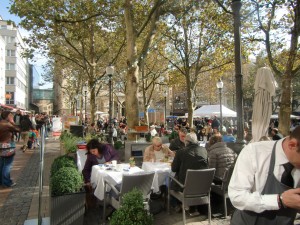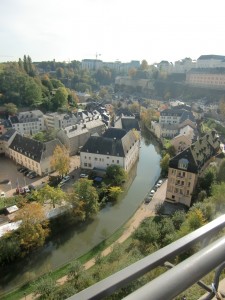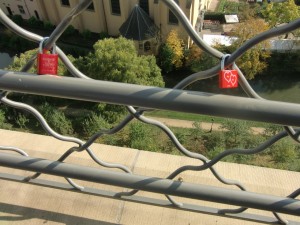CRUISING THE RHINE AND MOSEL RIVERS – A VISIT TO LUXEMBOURG (PART 2)
CRUISING THE RHINE AND MOSEL RIVERS
This is the ninth in a series of articles about cruising the Rhine and Mosel Rivers
A VISIT TO LUXEMBOURG (PART 2)
By Charles N. Stevens
Photos by Dolores Seidman
After the gravity and sadness of the American and Sandweiler cemeteries, we are on our way to the city of Luxembourg. Once off the bus, the pulse of life is all around us, a walking mall crowded with shoppers and strollers and a large square where people sit dining or sipping beer, wine or coffee at what seems hundreds of tables outside in the sunshine. We noticed that the items in the store windows were very expensive.
Almost immediately we are ushered into a nearby restaurant, Le Cercle, for a delicious meal of salad and quiche Lorraine followed by a dessert of sweet flan. The clinking of silverware and the babble of our voices fills the small room.
Outside again, we walk among the throngs of locals and tourists, noticing how well-dressed and perfectly coiffed the young women were. They appeared to be stepping out of a fashion runway, but more natural, reminding us of women in Paris. We again look out on the spacious square, a good part of which is devoted to stalls displaying antiques. I admire the European custom of people spending hours outside at small tables chatting and drinking with one another or simply observing the passing scene. They always seem relaxed and having a good time. Some bought hamburgers and fries from MacDonald’s, also located on the perimeter of the square.
Gathering at one corner of Liberation Square, we listen to a tour guide who spews so much information at us so rapidly that we can hardly comprehend it. I suppose she is doing her job, but we don’t get much out of it. Led by the guide our group walks by the Palais Grand Ducal where a soldier marches smartly up and down, clicking his heels as he turns to march the opposite way. The Grand Duke (Henri) does not live here, choosing to live at a palace outside of town. We pass by the rather plain City Hall or Hotel de Ville (the official language is French) where the red, white and pale blue flag of Luxembourg waves in a light wind. Along with French, however, the countrymen also speak German and Luxembourgian.
Walking precariously over a cobblestone street, we arrive at a place where we can peer over a sheer precipice to the river and the old town below. It is truly amazing to look down so far at the buildings and roads of the old town, as though we were flying over it. A red and white train zips by on a trestle near the town. The Alzette River flows slowly in great curves far below, winding its way around the medieval looking town and open fields, the view like a hazy fantasy.
As we lean on the thick wire fence, looking down at the scene, we notice a scattering of locks fastened to this same fence. These are the tokens of lovers, their names crudely inscribed on the locks to signify their undying love. I wonder if one of the two still has the key in case of a breakup.
From this same view point we also saw at a distance the towering skyscrapers of modern Luxembourg, its humming business and financial center.
Our guide continues to feed us facts. Luxembourg is a small landlocked country of less than one thousand square miles where only a half million people live. Like most of the cities of Europe, it was once occupied by the Romans who built a large fortress here. It was once a bastion on the Spanish Road and later was governed by Belgium and the Netherlands. 87% of the citizens are Catholic, including the royal family. We had passed the 1613 cathedral founded by the Jesuits when it was under Spanish rule. Officially the country is called the Grand Duchy of Luxembourg, the only one remaining in Europe. They have a representative democracy with a constitutional monarch headed by the Grand Duke. He has the power to dissolve parliament.
We have a beautiful trip home through valleys of autumn-touched trees clustered along splashing brooks. By the end of the day the sky is covered once again with a high overcast dripping with light sprinkles. Wine trailers pulled by tractors are heaped with green grapes on their way to the wineries.
Back on the boat, we dine on sauerbraten served with red cabbage and potato dumplings, the perfect end to a busy day.

"I admire the European custom of people spending hours outside at small table chatting and drinking with one another."

"It is truly amazing to look down so far at the buildings and roads of the town below."

"These are the tokens of lovers, their names crudely inscribed on the locks to signify their undying love."

"From this same viewpoint we also saw at a distance the towering skyscrapers of modern Luxembourg, the humming business and financial center."
MONTEREY PARK AUTHOR PUBLISHES 3RD BOOK ABOUT HIS EXPERIENCES IN WORLD WAR II- BACK FROM COMBAT
Charles “Norm” Stevens, a 40 year resident of Monterey Park and World War II Veteran has recently published the 3rd in his series about his experiences in WW II, Back from Combat: A WWII Bombardier Faces His Military Future. This book details the time from when he returned from combat in England where he flew 34 missions over Germany and France until the end of the war. Faced with large numbers of returning combat vets, and not knowing how long the war would continue, the military had to plan for their future. His options were whether to return to combat, become an instructor in the U.S., or receive new training that he would use in the Pacific. The book concludes with the end of the war with an Afterward that includes an update on the B-l7’s still flying in the U.S., as well as present day accounts pertaining to the war.
Stevens is the author of two previous books about his experiences:
An Innocent at Polebrook: A Memoir of an 8th Air Force Bombardier (Story of his 34 bombing missions from his base at Polebrook, England over Germany and France)
The Innocent Cadet: Becoming A World War II Bombardier (A prequel to the first, telling of his training in the U.S. before going overseas into combat.)
He is known to the readers of The Citizen’s Voice as the author of Travel Log Articles including “From Paris to Normandy on the Seine”, “Exploring New York” and “In Search of Snow.” He is retired, having taught for 32 years, primarily in the Montebello Unified School District.
Those interested in purchasing an autographed copy of any of his books, may contact the author at 323-721-8230 or Normstevens24@gmail.com.



